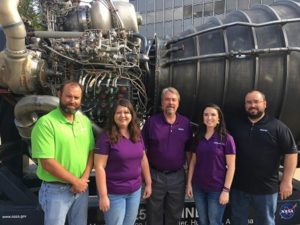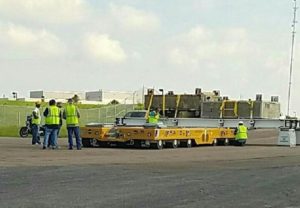
CH2M engineers (left to right): Stephan Herald, Pamela Stanley, Jamie Crews, Ashley Neeley, and Raymond Carter next to an RS-25
NASA is best known for scientific discovery and innovation, but even its top scientists need a little help to bring epic plans to fruition and boldly go where no one has gone before. To do that, logistics play a key element. CH2M engineers are working with NASA to move rocket components as they are readied so spacecraft can take over at liftoff to carry astronauts, supplies, and satellites out of the Earth’s atmosphere. And our engineers at NASA’s Marshall Space Flight Center in Huntsville, Alabama, are planning for their biggest move yet. They’re preparing to move the largest rocket booster ever built.

CH2M staff testing one of the four heavy-lift transporters that will be used to transport core stage from SSC to KSC. Photo courtesy of NASA.
NASA’s Space Launch System (SLS) will launch astronauts on missions to an asteroid and eventually to Mars, including robotic scientific missions to Mars, Saturn, and Jupiter.
CH2M engineers are developing procedures and training operators for the complex task of moving the rocket. SLS core stage is the heart of this system. Towering more than 200 feet tall with a diameter of 27.6 feet, the core stage will contain 730,000 gallons of super-cooled liquid hydrogen and liquid oxygen that will fuel the RS-25 engines for flight. The mass of core stage, including the ground support equipment and transporters to move it, weighs in at nearly one million pounds.
CH2M engineers are tasked with overcoming the challenges accompanying the monumental task of transporting the core stage from Michoud Assembly Facility in New Orleans, Louisiana, to Kennedy Space Center in Florida for final integration and launch. In addition to ground transportation, the CH2M team also is responsible for developing and planning the lifting of the core stage from its transportation system, rotating the booster to vertically lifting it by crane nearly 300 feet and loading it into the B2 test stand at Stennis Space Center near Bay St. Louis, Mississippi, for development and qualification testing.
This team exemplifies CH2M’s core values, principles, and purpose by helping lay the foundation for human progress by showing excellence in everything it accomplishes at the Marshall Space Flight Center.
